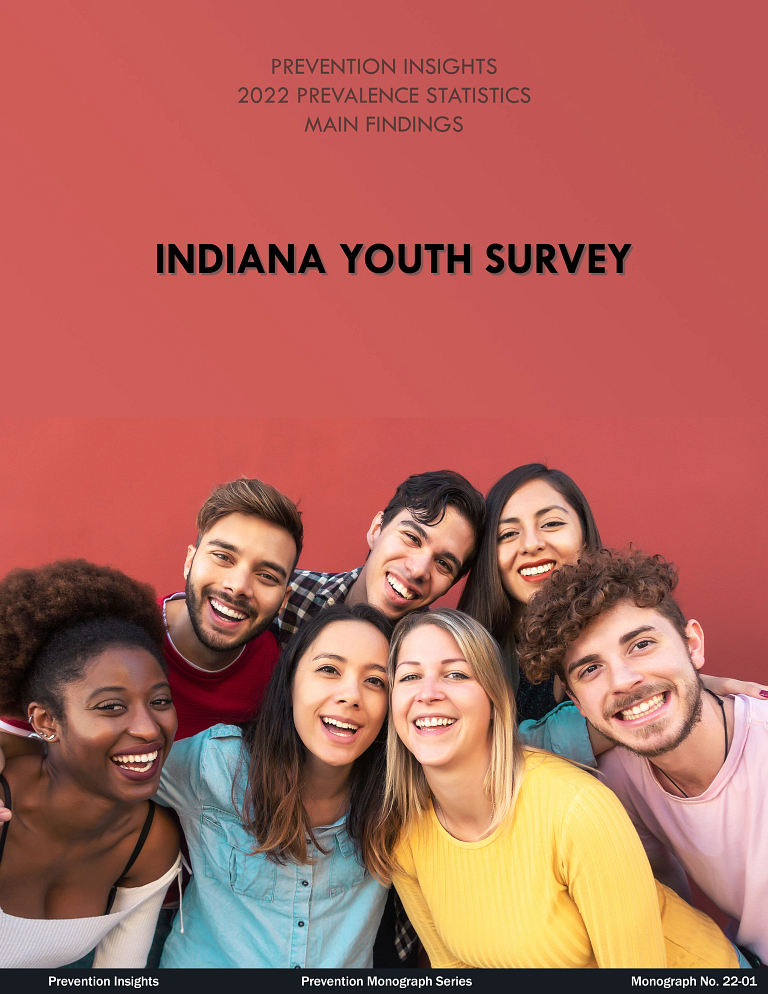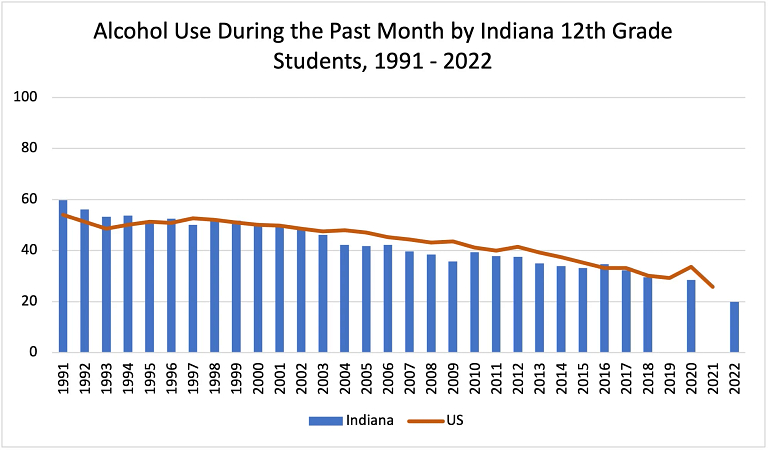
BLOOMINGTON – According to a recurring survey, the past two years have seen some of the largest decreases in substance use among Indiana youth in over 30 years.

The 2022 Indiana Youth Survey — administered in the spring by Prevention Insights, a part of the Department of Applied Health Science at the Indiana University School of Public Health-Bloomington — also found that fewer Hoosiers in grades 6 through 12 reported substance use in the past month in 2022 compared to 2020.
The numbers, which are based upon responses from over 90,000 Hoosier students at 323 schools, represent some of the largest decreases in substance use since the survey began in 1991, and are in line with similar decreases nationwide.
Among substances with the lowest prevalence rates in 30 years were cigarettes, alcohol, and marijuana. Alcohol use in the 30 days prior to taking the survey among 12th-graders, for instance, was 39.8 percentage points lower than in 1991 when it was 59.7% — the highest-ever reported for this survey. Cigarette use among 11th-graders was down 37.3 percentage points from a high of 40.1% in 1996, and marijuana use among 10th-graders was down 16.5 percentage points from a high of 24.9% in 1996.

“We have never seen such substantial decreases since I began leading the survey, and we suspect these data reflect unexpected consequences of the COVID-19 pandemic,” said Ruth Gassman, a senior scientist at the IU School of Public Health-Bloomington and the executive director of the Indiana Prevention Resource Center, who leads the survey. “The pandemic has disrupted adolescents’ daily lives and may have prevented youth from accessing substances.”
Additional highlights from the report include:
- Alcohol remained the most common substance used by Indiana youth, but the percentages of 12th-graders who reported drinking alcohol in the 30 days prior to taking the survey dropped from 28.5% in 2020 to 19.9% in 2022.
- Electronic vapor products were the second-most-used substance by Indiana teens. The percentage of 12th-graders who reported using vaping products during the past 30 days decreased from 23% in 2020 to 14.8% in 2022.
- The survey found that students across grades 7 to 12 reported decreased use of alcohol, cigarettes, electronic vapor products, marijuana, and prescription drugs not prescribed to them compared to 2020.
- Cigarette and alcohol use during the past month was also less prevalent among sixth–graders compared to 2020.
- The percentage of 12th-graders who reported believing that it is easy — “sort of easy” or “very easy” — to get alcohol decreased from 63.8% in 2020 to 57.9% in 2022.
- Students across grades 7 through 12 also reported decreased levels of perceived availability of alcohol, cigarettes, marijuana, and drugs like cocaine, LSD or amphetamines compared to 2020.
- For students who drank alcohol in the past year, parents were the primary source of alcohol for seventh- and ninth-graders, while students in grades 10 through 12 were most likely to report getting it at a party.
- Very few students reported purchasing alcohol from a retailer.

“These declines are positive news, but it’s unclear whether these trends will continue,” said Jon Agley, an associate professor at the School of Public Health-Bloomington and deputy director of research at Prevention Insights. “Since youth often use substances with peers and outside the home, it will be important to learn whether these are long-term shifts or more of a ‘blip’ on the radar.”

He said another area that warrants continued observation is the impact of the recent FDA ban on vaping products produced by Juul.
“It’s hard to know what the landscape will look like for youth vaping in 2024,” Agley said. “In our survey, use of electronic vapor products hit its peak in 2018 and declined in 2020 and 2022, even though vaping remains much more common than any other form of tobacco consumption.”
The survey also asked students about their mental health, finding that students across all grade levels reported moderate increases in feelings of depression and other negative mental health indicators compared to 2020. For instance, the percentages of sixth-graders who reported feeling sad or hopeless almost every day for two weeks or more in a row during the past year increased from 28.9% in 2020 to 35.2% in 2022.
The 2022 Indiana Youth Survey was funded by the Indiana Family and Social Services Administration’s Division of Mental Health and Addiction.
This is the 30th time that the Indiana Youth Survey, formerly called the Alcohol, Tobacco, and Other Drug Use Survey, has been conducted. Originally an annual survey, it began a biennial administration schedule in 2018. The next survey will be administered in 2024.
Information: News at IU Bloomington



